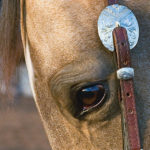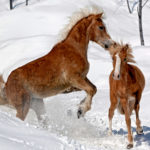I just started a new diet based on replacing fatty and sugary foods with good old protein and high fiber options.? Actually, besides missing sweets, I enjoy eating vegetables (with the exception of broccoli) and whole grains.? My biggest problem is with proportion size. ?I don’t have a kitchen scale to actually weigh 3 ounces of chicken breast, so I am using the ?no bigger than my thumb? rule for my meat portions.? ?Basically, I am looking at volume to estimate the calories of the food. Horse Industry?s Measurement Standard Horse owners are notorious for eyeballing and estimating how much they should feed their charges. As an industry, we typically use the standard measurements of ?a scoop of this?, and ?a flake of that?.? Eyeballing feed or feeding by volume often leads to over or underweight horses or wasted feed. How much WILL a horse eat? We have all used the saying ?I am as hungry as a horse!?? Horses will eat to meet their energy needs and if the feed is tasty enough, continue to eat. Overeating doesn’t apply just to grain. Horses will also overeat on lush pastures or high quality legume hays.? Horses should be fed according to their nutritional demands that will be determined in part by their age, activity level, reproductive status and their weight or conditioning. How Much SHOULD a Horse Eat? A horse will eat between 1.5 ? 3 % of its body weight in dry matter (DM) intake, depending on its energy demands.?All adult horses should receive at least 1% DM intake of their body weight in forage, that is, a 1000-pound horse would need at least 10 pounds of forage per day on a dry matter basis. Even for high performance horses, forage should make up at least 50% of the total ration.?Remember that the 1% body weight rule and the 50% of the total ration rule are minimal forage requirements, not necessarily optimum requirements for most horses. ??Below is a table from the 1989 NRC for horses.? It gives a good estimate of how much forage and concentrate (grain) a horse should eat based on their work load or reproductive status. Weighing Your Feed When you feed your horse, be sure to feed by?weight, not by volume. ?Different feedstuffs have different energy concentrations. The same volume of corn (a scoop), will weigh more than a scoop of oats.? In addition, the digestible energy content of corn (Mcals per pound) is expected to be about 15% more than oats.? Because of both weight per volume and energy density differences, a scoop of corn may actually provide close to twice the amount of energy as compared to a scoop of oats. If you feed the horse the same volume of corn as you do oats, you would be feeding the horse twice as much grain as it needs. If you feed the horse the same amount of oats as you usually do corn, you would be underfeeding the horse. You can still use a scoop or coffee can to measure your grain, but weigh out the desired portion of grain, put it in the scoop or can, and mark a line so that you know where to fill the can to. When you change feeds, even to one similar to what you already use, be sure to weigh the new feed and adjust the amounts if necessary.? Remember, if you switch to a concentrate that has added dietary fat, you can feed less of the feed to maintain your horse’s weight. Don’t forget that different types of hay have different weights, too. For example, a flake of grass hay can appear the same or larger than a flake of alfalfa but still weighs less. So initially weigh out your hay. When you feed hay, just as with grains, it’s a good idea to weigh the new feed to see if you need to adjust the amounts accordingly. Helpful Hint:?Changing the type of grain or forage should be done slowly over a period of 10 days to ensure the microbial populations in the horse’s digestive tract have a chance to adjust to the new feed source.









